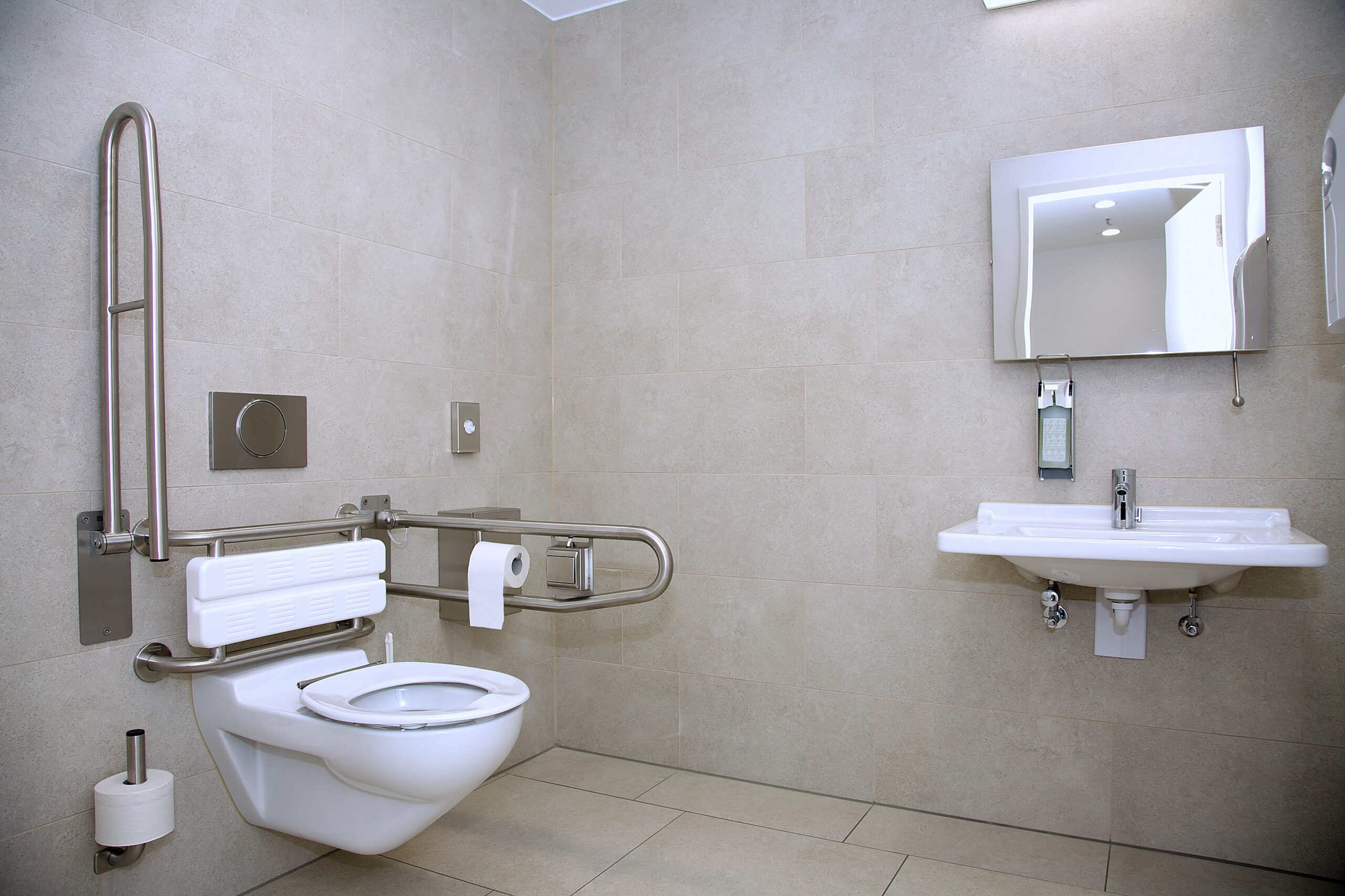Creating Independent Spaces with Handicap Restroom Design

Handicap restroom design ensures independence for individuals with disabilities, older adults, and others requiring inclusive facilities. While basic Americans with Disabilities Act (ADA) compliance sets minimum standards, universal design creates spaces that work better for everyone, promoting dignity and independence through thoughtfully designed facilities.
Beyond these basic requirements, modern accessible restrooms incorporate advanced features that enhance the user experience. Innovations like no-touch fixtures – faucets, soap dispensers, hand dryers – enhance hygiene and accessibility for individuals with mobility challenges, while adjustable, multifunctional fixtures accommodate varying user heights and abilities.
Though the ADA provides baseline standards for stall dimensions, grab bar placement, and sink accessibility, universal design takes a more holistic approach. This broader perspective addresses the challenges of an aging population by reducing fall risks and fostering inclusivity, encouraging participation from individuals who might otherwise avoid locations with inadequate facilities.
For many people, using a public restroom is a simple matter of convenience. However, universally designed restrooms are crucial for full social participation, empowering individuals with disabilities and older adults to use facilities independently and maintain their dignity and self-esteem.
While implementing universal design brings significant challenges – from costs to space limitations in existing buildings – the long-term benefits often justify the investment. Increased customer satisfaction and broader patronage can offset initial expenses, especially when paired with creative solutions and thoughtful planning to maximize usability within space constraints.
Fortunately, growing awareness through advocacy and education among builders, architects, and business owners is leading to wider adoption of these inclusive practices.
Meeting the Restroom Needs in Handicap Restroom Design
Effective handicap restroom design must consider the diverse needs of individuals who experience restroom-related challenges, including those with mobility impairments and medical conditions. What many take for granted – the ability to go several hours between bathroom breaks – can be a daily struggle for others, profoundly impacting their ability to live life fully.
This “restroom duress” transforms simple activities like shopping or enjoying outdoor recreation into complex challenges, as highlighted by recent surveys where park and trail users consistently ranked public restrooms as their top priority. For many, even a quick trip to the store requires careful planning and creates unnecessary anxiety about restroom availability.
The need for accessible facilities touches more lives than most realize. Beyond those with mobility challenges, a significant portion of our community faces restroom-related difficulties, from parents with young children to individuals managing chronic conditions. These include people living with Irritable Bowel Syndrome, Ulcerative Colitis, or incontinence, as well as those undergoing medical treatments that affect bladder or bowel function.
Even everyday factors like certain medications or morning coffee can create urgent needs that many of us understand all too well. As we age, these challenges often increase, making accessible facilities not just a convenience but a necessity for maintaining an active, independent lifestyle.
“For those using a wheel chair, problems compound,” states the American Restroom Association. “They disproportionately suffer these conditions, while facing a greater challenge finding accessible facilities.”
Today’s ADA compliance reaches beyond physical spaces into the digital realm, ensuring both buildings and websites accommodate everyone’s needs. As we explore current trends in accessible design, we’ll see how thoughtful innovation is reshaping both our physical and digital environments to create truly inclusive spaces for all.
Trends and Examples in Handicap Restroom Design
Modern handicap restroom design has evolved far beyond basic accessibility requirements into an art form that seamlessly blends function, comfort, and style. Today’s designs recognize that accessible spaces can be both beautiful and practical, creating environments where everyone feels welcome and independent.
Leading architects and designers are reimagining traditional elements with innovation and elegance. Grab bars, once purely utilitarian, now double as sleek towel racks in sophisticated finishes that complement any décor. Spacious layouts with zero-threshold entries not only accommodate wheelchairs but create an open, luxurious feel that benefits everyone.
Smart technology is revolutionizing the accessible bathroom experience in remarkable ways:
- Touchless fixtures with motion sensors eliminate contact points while adding a touch of modern convenience that all users appreciate.
- Voice-activated controls allow independent operation of everything from lighting to water temperature, empowering users with limited mobility.
- Smart toilets with automatic functions and built-in bidets provide enhanced hygiene and independence, becoming increasingly popular in upscale accessible designs.
The thoughtful integration of safety features has become an art in itself:
- Non-slip flooring incorporates elegant patterns and textures that enhance both safety and aesthetics.
- Strategic lighting combines ambient and task illumination to create both beauty and security.
- Adjustable-height features are cleverly disguised within contemporary design elements, maintaining style while maximizing functionality.
Essential components now seamlessly blend into the overall design while exceeding accessibility standards. Modern toilets with raised seats appear sleek and contemporary, while strategically placed grab bars in designer finishes provide crucial support without looking institutional. Zero-entry showers with built-in seating and adjustable fixtures create spa-like environments that work beautifully for everyone.
As we explore how building owners can implement these innovations effectively, it’s clear that modern accessible design is about creating spaces that don’t just meet standards – they exceed expectations for both function and style.
Essentials in Handicap Restroom Design for Wheelchair-Accessible Stalls
Handicap restroom design centers on creating spaces that work for everyone, especially those using wheelchairs and other mobility aids. Every dimension serves a purpose, ensuring proper turning radius and support for maximum independence.
In multi-fixture restrooms, accessibility extends beyond stalls. Fixtures must be positioned to accommodate wheelchairs while remaining comfortable for all users.
|
Feature |
Requirement |
Considerations for Children |
|
Wheelchair-Accessible Stall |
Min. 60″ wide x 56″ deep; 32″ doorway; Grab bars 33″-36″ AFF (42″ rear, 54″ side) |
Ages 3-4: Lower grab bars, toilet seat. Ages 5-12: Ensure age-appropriate accessibility and comfort. |
|
Urinal (if multiple) |
At least one: Rim no higher than 17″ AFF; Flush controls no higher than 44″ AFF |
Ages 3-4: Lower urinal. Ages 5-12: Ensure age-appropriate accessibility and comfort. |
|
Sink & Mirror |
At least one: Sink rim no higher than 34″ AFF; Knee clearance min. 27″H x 30″W x 19″D; Mirror bottom edge no higher than 40″ AFF |
Ages 3-4: Lower sink. Ages 5-12: Ensure age-appropriate accessibility and comfort. |
|
Ambulatory Accessible Stall |
(If 6+ toilets/urinals or stalls) Min. 36″ wide x 48″ deep; 32″ doorway; Grab bars |
Ages 3-4: Lower grab bars, other age-appropriate features. Ages 5-12: Ensure age-appropriate accessibility and comfort. |
While standard ADA measurements work well for most adults, children’s needs vary significantly by age. A thoughtfully designed space takes these variations into account while maintaining safety and accessibility for all users.
“This space is essential for accommodating mobility aids such as wheelchairs, walkers, and scooters, as well as providing room for people to transfer to and from these devices,” according to Accessibility Checker. “Unobstructed floor space also allows people with visual impairments to move freely and safely, reducing the risk of tripping or falling.”
As building owners implement these requirements, they’re creating accessible spaces and ensuring dignity and independence for all users.
How Building Owners Ensure Compliance with Accessibility Standards
Building owners play a pivotal role in bringing handicap restroom design from concept to reality, transforming accessibility standards into welcoming spaces that truly serve all users. Success requires not just technical knowledge, but a commitment to understanding and meeting diverse needs through thoughtful design.
Creating an accessible restroom starts with essential elements that blend function and comfort. Spacious layouts allow people using mobility aids to move freely and confidently. Well-chosen fixtures, from touch-free faucets to carefully positioned grab bars, make independence possible for users of all abilities. Thoughtfully placed partitions ensure privacy while maintaining accessibility, while clear signage helps everyone navigate with dignity.
The journey from blueprint to built environment requires close partnership between building owners and architects. The most successful projects emerge from meaningful dialogue between design teams and the disability community, whose lived experiences provide invaluable insights into creating truly functional spaces.
While challenges like budget constraints and outdated building codes inevitably arise, innovative solutions often emerge through collaboration. Forward-thinking building owners engage with the design community through workshops and feedback sessions, learning from accessibility experts to create better solutions.
The ultimate goal extends beyond compliance to creating genuinely safe and comfortable spaces. When building owners prioritize features like optimal lighting, reliable security, and regular maintenance, they foster an environment of true inclusivity.
“To achieve an inclusive restroom design, various design elements must be integrated,” according to The Havok Journal. “These include spacious multi-stall layouts that allow for the movement of individuals with mobility aids, such as wheelchairs, and the installation of appropriate fixtures that comply with plumbing codes. The placement of partitions should also be carefully considered to ensure privacy while maintaining accessibility. Additionally, the use of accessible signage is crucial in guiding users to the restroom facilities.”
American Specialties, Inc.
American Specialties, Inc. (ASI) develops your handicap restroom design concepts by taking functionality and user experience to the next level. For customers who demand innovative products, ASI offers a complete collection of commercial and office washroom equipment.
Additionally, ASI Group designs, engineers, and manufactures from a single source. This includes fully integrated washroom accessories, partitions, lockers, and visual display products. It’s just the beginning of what ASI has to offer.
By incorporating must-have accessories, you can create a commercial restroom that is both stylish and functional.

